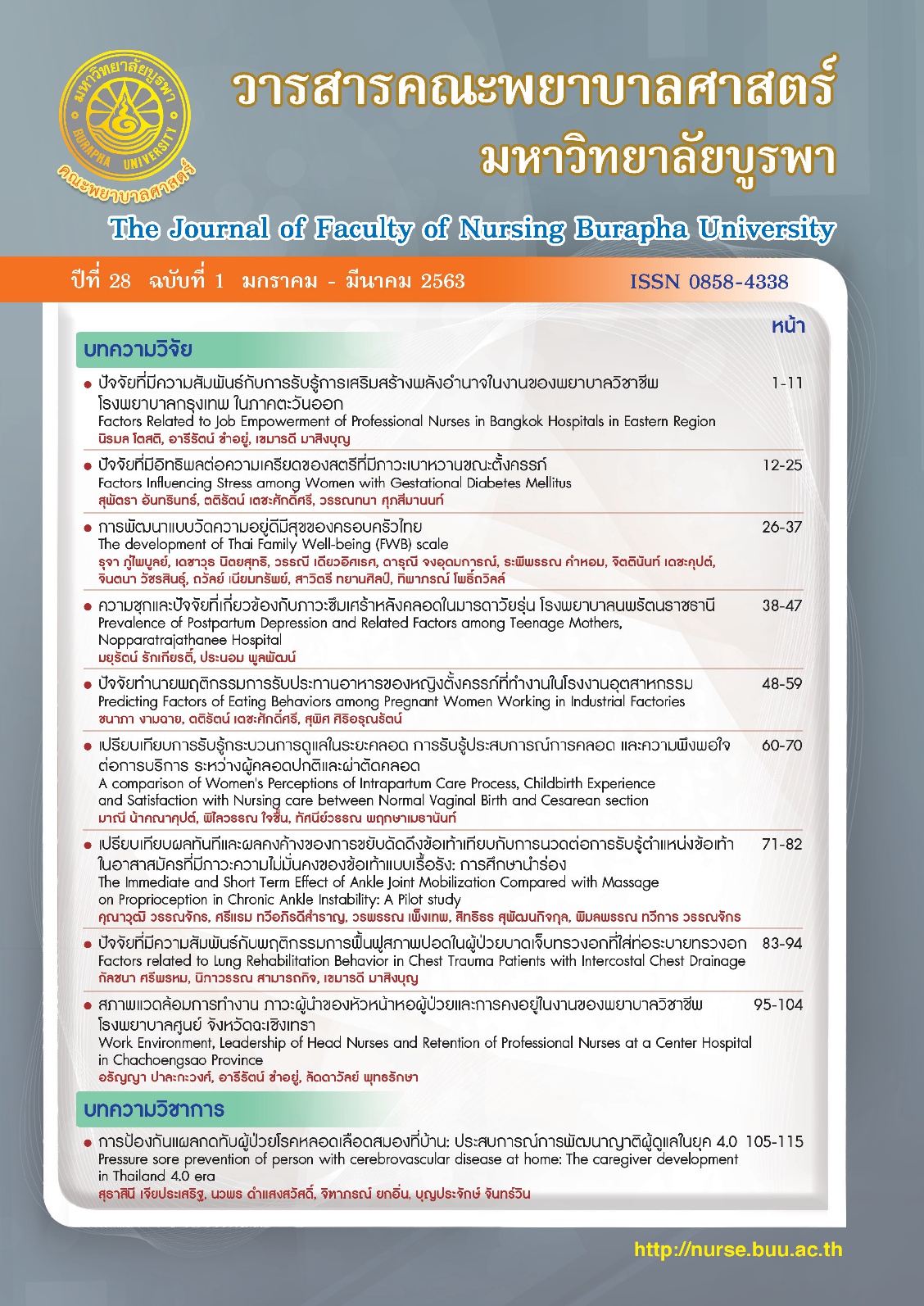เปรียบเทียบการรับรู้กระบวนการดูแลในระยะคลอด การรับรู้ประสบการณ์การคลอด และความพึงพอใจต่อการบริการ ระหว่างผู้คลอดปกติและผ่าตัดคลอด
คำสำคัญ:
การรับรู้กระบวนการดูแลในระยะคลอด, การรับรู้ประสบการณ์การคลอด, ความพึงพอใจต่อการบริการ, การคลอดปกติ การผ่าตัดคลอดบทคัดย่อ
บทคัดย่อ
การศึกษาแบบพรรณนาเชิงเปรียบเทียบครั้งนี้มีวัตถุประสงค์เพื่อเปรียบเทียบการรับรู้กระบวนการดูแลในระยะคลอด ประสบการณ์การคลอด และความพึงพอใจต่อการบริการระหว่างผู้คลอดปกติและผ่าตัดคลอด กลุ่มตัวอย่างเป็นผู้คลอดที่ได้รับการดูแลในห้องคลอดโรงพยาบาลปทุมธานี ในช่วงระหว่างเดือนธันวาคม 2558 ถึง สิงหาคม 2559 จำนวน 359 คน โดยเลือกแบบเฉพาะเจาะจง เครื่องมือที่ใช้ในการรวบรวมข้อมูลประกอบด้วย 4 ส่วน ได้แก่ แบบบันทึกข้อมูลส่วนบุคคล แบบประเมินการรับรู้กระบวนการดูแลในระยะคลอด มีค่าความเชื่อมั่น .86 แบบประเมินการรับรู้ประสบการณ์การคลอด มีค่าความเชื่อมั่น .81 และแบบประเมินความพึงพอใจต่อการคลอด วิเคราะห์ข้อมูลโดยใช้สถิติเชิงพรรณา สถิติทีแบบอิสระต่อกัน (Independent t-test) และสถิติแมนวิทนีย์ยู (Mann-Whitney U-test)
ผลการวิจัย พบว่าผู้คลอดปกติมีค่าเฉลี่ยการรับรู้กระบวนการดูแลในระยะคลอด ( =57.75, SD=15.09) การรับรู้ประสบการณ์การคลอดทางบวก ( =76.96, SD=9.90) และค่าเฉลี่ยความพึงพอใจต่อการบริการอยู่ในระดับปานกลาง ( =6.90, SD=2.11) โดยมีคะแนนเฉลี่ยสูงกว่าผู้ที่ผ่าตัดคลอดทั้ง 3 ด้าน ( =54.87, SD=15.70; =72.91, SD=10.73; =6.81, SD=2.09 ตามลำดับ) การรับรู้กระบวนการดูแลในระยะคลอดและความพึงพอใจต่อการบริการระหว่างผู้คลอดปกติและผ่าตัดคลอด ไม่แตกต่างกันอย่างมีนัยสำคัญทางสถิติ (t=1.783, p >.05 และ Z= -.449, p= .653) ตามลำดับ ส่วนการรับรู้ประสบการณ์การคลอดแตกต่างกันอย่างมีนัยสำคัญทางสถิติ (t= 3.679, p< .001) ผลการวิจัยเสนอแนะว่า พยาบาลควรส่งเสริมการรับรู้ประสบการณ์การคลอดที่ดีแก่ผู้ที่ผ่าตัดคลอด ให้มารดาได้โอบกอดสัมผัสทารกแรกเกิดและให้ทารกได้ดูดนมโดยเร็ว
เอกสารอ้างอิง
Chomkhuntod, P., Charuwatcharapaniskul, U. & Chareonsanti, J. (2014). Effects of childbirth preparation on pain level, duration of labor, and perceptions on childbirth experience in adolescent pregnant women. Nursing Journal, 41(1), 13-25. (In Thai)
FIGO Committee on Safe Motherhood and Newborn Health. (2014). Mother and newborn friendly birthing facility [Internet]. Available from: https://www.figo.org/sites.
Hakularb, P., & Thananowan, N. (2008). Barrier of initial breastfeeding in labor room. Nursing Journal, 24(2), 14-23. (In Thai)
Hanucharurnkul, S., Jeangsawan, N. & Partiprajak, S. (2009). Results and evaluation of advanced nursing practitioners in Hanucharurnkul S. and Panpakdee O. (Ed.) Advanced Nursing Practice: Integrating into Practice. Bangkok: Judthong. 87-113. (In Thai)
Iliadou, M. (2012). Supporting women in labor. Health Science Journal, 6(3), 385-391.
Irvine D., Sidani S., & McGills-Hall l. (1998). Linking outcome to nurse’s role in health care. Nursing Economic, 16(2), 58-64.
Jaichaun, P. & Kanoathes, T. (2013). Effect of skin to skin between mothers and newborns after birth immediately on maternal satisfaction and breastfeeding at 6 weeks and 6 months. Paper presented at the 4th National Breastfeeding Conference, Bangkok: Miracle Hotel.
(In Thai)
Junsopa, M., Baosoung, C. & Parisunyaku, S. (2012). Effects of social support on labor pain and perception of childbirth experience among primiparous adolescent parturients. Nursing Journal, 39(4); 71-84. (In Thai)
Kifle, M.M., Ghirmai, F.A., Berhe, S.A., Tesfay, W.S., Weldegebriel, Y.T., & Gebrehiwet, Z.T. (2017). Predictors of Women’s Satisfaction with Hospital-Based Intrapartum Care in Asmara Public Hospitals, Eritrea. Obstetrics and Gynecology International. Retrieved 7 November 2019 from https://www.hindawi.com/journals/ogi/2017/3717408/.
Kujawski, S., Mbaruku, G., Freedman, L.P., Ramsey, K., Moyo, W., Kruk, M.E. (2015). Association between disrespect and abuse during childbirth and women’s confidence in health facilities in Tanzania. Maternal and Child Health Journal, 19(10), 2243–2250.
Lucas, M.T.B., Rocha, M.J.F., Costa, K.M.M., Oliveirap, G.G., & Melo, J.O. (2015). Nursing care during labor in a model maternity unit: cross-sectional study. Online Brazilian Journal of Nursing, 14(1), 1-7.
Marut, J.S., & Mercer, R.T. (1979). Comparison of primipara’s perceptions of vaginal and cesarean births. Nursing Research, 28(5), 260-266.
Melese, T., Gegrehiwot, Y., Bisetegne, D. & Habte, D. (2014). Assessment of client satisfaction in labor and delivery services at a maternity referral hospital in Ethiopia. Pan African Medical Journal, 17(76), 1-9.
Mocumbi, S., Hogberg, U., Lampa, E., Sacoor, C., Vala, A., Bergstrom, A., … & Sevene, E. (2019). Mothers’ satisfaction with care during facility-based childbirth: a cross-sectional survey in southern Mozambique. BMC Pregnancy and Childbirth, 19(19), 303-317.
Nakanakupt, M., Kanungbutr, P. & Noykerd, T. (2018). Relationship between perceptions of Intrapartum care Process, childbirth experience perception and satisfaction with nursing care among parturients. Nursing Journal, 45(1), 50-61. (In Thai)
Okafor, I.I., Ugwu, E.O., Obi, S.N. (2015). Disrespect and abuse during facility-based childbirth in a low-income country. International Journal of Gynecology and Obstetrics, 128(2), 110–113.
Parisunyaku, S., Baosoung, C. & Prasitwatanasaree, P. (2013). Predictors of women’s perceptions of the positive childbirth experience. Nursing Journal, 40(Supplement), 84-93. (In Thai)
Pirdil, M., & Pirdel. L. (2015). A comparison of women’s expectations of labour and birth with the experiences in primiparas and multiparas with normal vaginal delivery. Journal of Kathmandu Medical College, 4(1), 16-25.
Rocha, F.A.A., Fontenele, F.M.C., Carvalho, I.R., Rodrigues, I.D.C.V., Sousa, R.A., Ferreira Júnior, A.R. (2015). Care during labor and birth: mothers’ perception. Rev Rene, 16(6), 782-789.
Sauls, D. J. (2004). Adolescents’ Perception of Support During Labor. (4). 36-42.
Schneider, L.W., Crenshaw, J.T., & Gilder, R.E. (2012). Influence of Immediate Skin-to-Skin Contact During Cesarean Surgery on Rate of Transfer of Newborns to NICU for Observation. Nursing for Women’s Health, 21(1), 28–33.
Tosopon, S., Khanobdee, C. & Phumonsakul, S. (2017). Selected factors predicting childbirth experience of laboring women with unplanned cesarean section. Journal of Nursing and Health Sciences, 11(1), 159-170. (In Thai)
Tully, K.P. & Ball, H.L. (2008). Maternal accounts of their breast-feeding intent and early challenges after caesarean childbirth. Midwifery, 30(6), 712-719.
Velho, M.B., Santos E.K., Bruggemann, O.M., & Camargo, B.V. (2012). Experience with vaginal birth versus cesarean childbirth: Integrative review of women’s perceptions. December 1, 2019, accessed from http://www.scielo.br/pdf/tce/v21n2/en_a26v21n2.pdf.
World Health Organization. (2018). WHO recommendations: intrapartum care for a positive childbirth experience. Geneva: Licence: CC BY-NC-SA 3.0 IGO.





